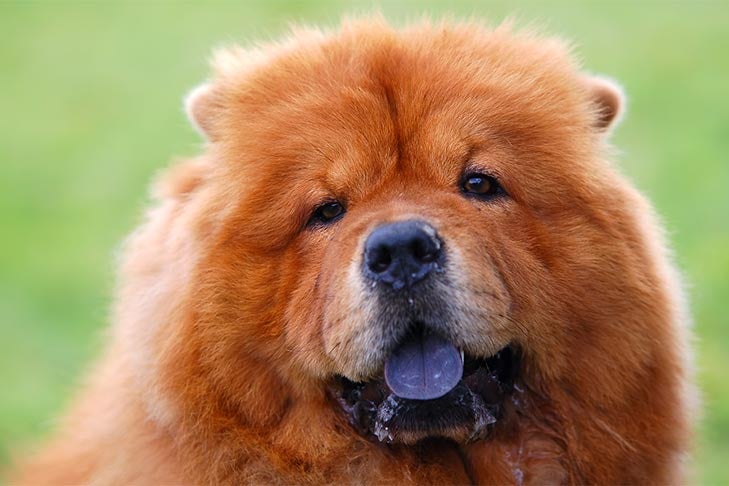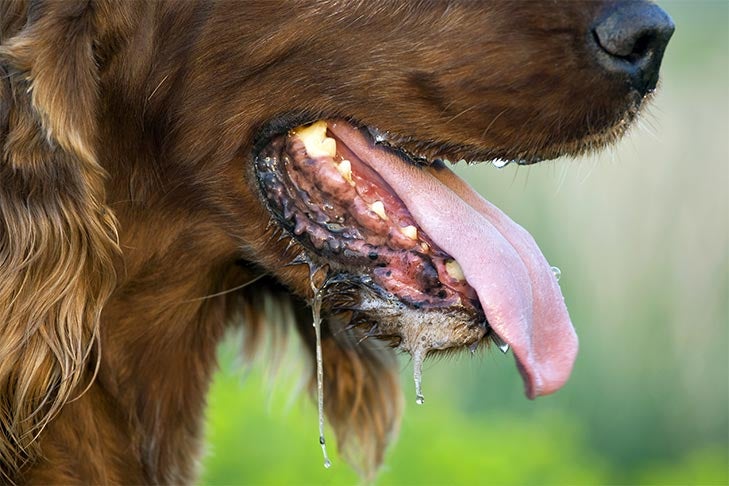
You might never have given much thought to your dog’s tongue, but it’s a vital organ for their well-being. Not only does it help them eat and drink, but it also aids with temperature regulation, grooming, and, to a certain degree, communication.
Most owners might expect a dog’s tongue to be a similar pink tone to ours, and, in most cases, that’s true. But if you have a dog with a blue tongue, it’s usually not something to panic about. Most of the time, there’s a genetic explanation for this phenomenon, as there is for the Chow Chow’s blue tongue—perhaps the most famous blue-tongued dog breed. But it’s not just the Chow Chow that sports this colorful tongue. Learn more about which dog breeds have blue tongues, why, and when a blue tongue is something to see your veterinarian about.
What Causes Dogs to Develop Blue Tongues?
If you have a dog with a blue tongue, it most likely comes down to genetics. “There are some dogs that have a bluish tongue, really more dark purple, and this can be due to breed and melanin, which gives the tongue a different color,” says Dr. Sarah Carotenuto, DVM and Assistant Professor at the University of Arizona College of Veterinary Medicine.
Melanin is a natural pigment that colors skin, hair, and eyes. It’s normal for certain areas (called “points”) on a dog’s paws, nose, lips, and around their eyes to be darker in color. When your dog’s tongue (and possibly the gums and other parts of the mouth) is blue or black, this tends to be because there is an overproduction of melanocytes (the highly differentiated cells that produce melanin) in this area, similar to what happens when birthmarks or freckles appear on people.

Only a handful of dog breeds are guaranteed to have entirely blue tongues. This mysterious genetic anomaly is still not fully understood. However, studies suggest that the blue-tongue phenotype (observable characteristics resulting from genetic makeup interacting with the environment) is found in a very small number of genes. The research found strong signals in Chow Chows for two specific genes (ASIP and PDPK1) relating to pigmentation that are also found in other animal species.
Some breeds, rather than having entirely blue tongues, are predisposed to developing blue-black spots on their tongues. This still relates to an overaccumulation of melanin, but blue-black tongue spots aren’t a guaranteed phenomenon like they are for a Chow Chow. The timing of development is also more random. Your dog might be born with these types of spots, or they may develop later in life.
Your dog might be more likely to have a blotchy tongue if both parents have one. Fortunately, you don’t have to worry about the harmless trait affecting their health.
Other Dog Breeds With Blue Tongues
If you’ve just welcomed home a Chow Chow puppy, you may notice their tongue is pink. But, just like Dalmatians, who only develop their spots at around 3 or 4 weeks old, Chow Chow tongues typically turn blue when they are about 8 to 10 weeks old. It can take up to six months for the transformation to take place completely.
There’s no cause for alarm if your elderly Chow Chow develops pink spots on their tongue. This is a usual part of their aging process. Dogs with dilute coat colors (a genetic mutation that results in lighter coat colors), such as cinnamon or blue, can also experience this loss of pigmentation.

Chow Chows might be the most well-known blue-tongued dog breed (and one where this trait is part of the breed standard), but they aren’t the only ones. It’s also a breed standard for the Chinese Shar-Pei (unless they have non-black, dilute pigmentation on their nose). The Eurasier can also have a solid or spotted blue-black tongue, as can breeds like the Thai Ridgeback.
Which Dogs Might Have Blue Spots on Their Tongues?
If your dog has blue-black blotches on their tongue, it doesn’t necessarily mean they have Chow Chow in their lineage. It can happen in any dog, but, as Dr. Carotenuto explains, it’s more likely to be seen in a breed with pigmented fur, including Australian Shepherds and Blue Heelers. Essentially any dog with any coat color other than solid white can have blue spots on their tongue. High pigment might also result in visible blue-black spots on other areas of the body, like the stomach or the roof of the mouth.
Breeds whose tongues may have blue-black spots include:
- Akitas
- English Cocker Spaniels
- German Shepherds
- Golden Retrievers
- Labrador Retrievers
- Mastiffs
- Newfoundlands
- Pomeranians
- Siberian Huskies
It’s not unusual to see pigmentation on the tongue of curly-tailed spitz breeds. But, while these breeds often share close ancestry with the Chow Chow, there’s nothing to suggest this is a definitive link.

Can Blue Tongues in Dogs Be a Medical Concern?
If you suddenly notice spots on your dog’s tongue where there weren’t any previously, or their tongue spots have markedly changed, don’t ignore this. Oral cancers, particularly melanomas, are common in dogs. Whether or not your dog’s tongue is blue, if you see a bump on your dog’s tongue that’s raised, inflamed, bleeding, discolored, or new, bring your dog to the vet for a checkup.
This is especially important if your dog is also losing weight or suffering from bad breath, excessive drooling, or lack of appetite. Early detection and treatment of tongue melanomas significantly improve the chances of a positive prognosis.
And, sometimes, a blue tongue can indicate a medical emergency. “As veterinarians, we get concerned when a dog whose tongue has never been blue or purple suddenly turns this color, especially if it is accompanied by difficulty breathing,” Dr. Carotenuto explains. “Blue or purple in these instances often means cyanosis, which means that the blood is unable to properly oxygenate.”

Immediately call your vet if you suddenly see a blue or purple tongue. Cyanosis is more commonly seen in dogs suffering from heart defects, lung disease, nervous and muscle system problems, and breathing issues, such as tracheal collapse.
“Of course, if your animal just snarfed down a blue lollipop or popsicle and has a teal tongue and is otherwise normal, it’s probably okay to monitor at home,” Dr. Carotenuto clarifies.

